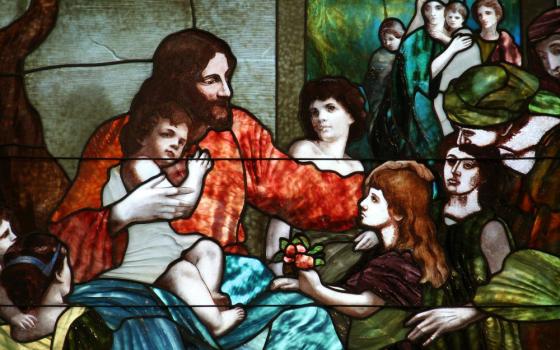It is an oversimplification to say that religious life will "look different" in the future. More accurate would be to say that it will be different. Cosmetic alterations can make us "look different." To be different is more than skin deep.
How much of the talk about the future of religious life is really about the future of our religious traditions, not the life itself?
When we see associates as our hope for the future or talk about turning our ministries over to them, our topic is no longer the continuance of currently-lived religious life. Is it more accurate to say that the most common, contemporary expression of our traditions (i.e. vowed religious life via institutional living tied to the church/church hierarchy) is no longer the only way to live these traditions? The reality is that we are expanding the ways we live the traditions, but our language hasn't caught up yet. We have to be bolder, more prophetic, in naming them as ways of living religious life.
In her recent interview with Oprah Winfrey, Benedictine Sr. Joan Chittister told Oprah that it is the healing Jesus we follow most easily. The Jesus who fed crowds and healed the sick and forgave sinners. But, she said, our challenge is to follow the prophetic Jesus. The Jesus who threatened the status quo, demanded that systems designed to keep the poor poor and to hold women down be changed. The Jesus who refused to defend power and greed and sexism and war. The Jesus who spoke the prophetic message so clearly that he was crucified for it.
Jesus also told us not to go it alone. He called us to tend to each other as well as all others. He called women as well as men not only to follow but to lead (2,000 years of patriarchal theology notwithstanding). He called some, though not all, to leave everything for the sake of his work. He called everyone to care for the common good: to love others, to show mercy, to forgive, even our enemies.
Human beings long for connection — at some level we know that we can each be a better "me" together than when we are alone. And something in our very nature draws us to the good, to the divine, however we conceive of it and whatever we name it. Combine the longing for connection and the pull towards the good with the call to follow Jesus, and you have the makings of Christian community. Add prophetic and charismatic leaders of any era with a vision of following Jesus in a specific way, and you have the foundation of the traditions underlying our religious communities.
But we have to stop seeing what we have been trained to see over decades and see what really is: the prophetic moment we are living now as our traditions grow in as yet unrecognized ways. If we can stop focusing on adapting to changing demographics and embrace the different ways of living our traditions that are emerging, we can then deal in creative ways with questions like, Who will fill our empty buildings now? Who is called to do good works today? Who will carry our tradition into the future?
We can be the conveners. We can host the conversations, invite the questions, gather and engage seekers across lifestyles, commitments and generations to live our traditions in diverse ways. We are still vowed, we've still given our life to these traditions, facts which are not diminished by broadening or shifting definitions or even coining new terminology. Vowed members will continue to be as important to the lifeblood of the traditions as non-vowed members are coming to be.
The traditions that became religious communities were not born in isolation; many components came together to create each of them:
- the physical and spiritual suffering of people and the Earth
- human longing for connection, for community
- the desire for God, for goodness, truth and beauty
- a vision for a better world
- the source of wisdom, the voice of the prophet (Jesus, Buddha, Mohammed, the Goddess)
The initial spark of each specific tradition often came from a single visionary and eventually vowed religious women grew and developed the traditions — but we will never come to the point of exhausting the interpretation of any living tradition.
My own thinking has shifted. I now see us in a time of expansion of the traditions rather than an evolution of religious life. By clinging to a single model, we stop expansion and we stunt growth. Religious life now is vowed, yes. It is canonical. It is communal living among unrelated adults, often with shared finances. But that is only one way. Can we expand our vision and see how else it can be lived, is already being lived? Expanding our vision will require not only expanding experience but also expanding the language we use to describe what is becoming. What do we call non-vowed, non-canonical, non-financially dependent models of living our traditions? How do these different ways relate, how do we share experiences, what makes us different facets of a single lived tradition?
And how will vowed members be different? With less institutional focus, we will be nimbler in response to changing needs and circumstances. We can excise whatever remnants remain of authority models that suited large-scale institutional life and that attempted to mold women into one mind as a labor force for the church. Our relationships with those who share our traditions will continue to be an important asset in the educational institutions and service agencies we founded but no longer run; we're not "turning over our ministries," we're expanding our base.
Jesus and the Gospel are still the core. And around that core are vowed members who give their lives to the living traditions and to each other. And married couples and families who live the tradition even as they give their lives to their spouses and children. And those who love the tradition, find meaning in it, integrate it into their lives. For some, it will be a singular, lifetime commitment. But not for all, and that is OK.
This narrative isn't diminishment and replacement but expansion and cross-fertilization. There are communities already experimenting with new models, new living arrangements, new leadership models, virtual communities. We must be creative with structures and governance models, funding and financing. There will be legal issues to resolve. But unless human ingenuity and creativity have expired, this won't be a problem; religious women have always been resourceful in meeting whatever challenges and needs they face.
The increasing number of associates and oblates give testimony to the longing for community and connection and the desire to ease the burden of our suffering sisters and brothers and of our Earth. We see those same desires in seekers like Nuns & Nones and in movements calling for social change like #MeToo, #MarjoryStonemanDouglasHigh, #BlackLivesMatter.
We must find the disconnect between convents and monasteries that are emptying while streets and social media and schools of theology and divinity are filling with seekers and social justice activists of all ages, many of whom are inspired by the gospel of Jesus, working for the same new world as vowed religious women. Our task is to find intersections where we can learn from each other, discover the spaces — physical as well as virtual — where we can support each other and build the community to which Jesus calls us.
If we realize that our traditions are bigger than any one way, that the essence remains even while the form is changing, we will find our way. We will BE what is needed now.
[Linda Romey is a Benedictine Sister of Erie, Pennsylvania, and is the community's web developer/designer. She does marketing for them, Monasteries of the Heart and Benetvision. Prior to entering the Erie Benedictines, she worked seven years in Colombia. She is a former marketing and advertising manager for the National Catholic Reporter Publishing Company.]

